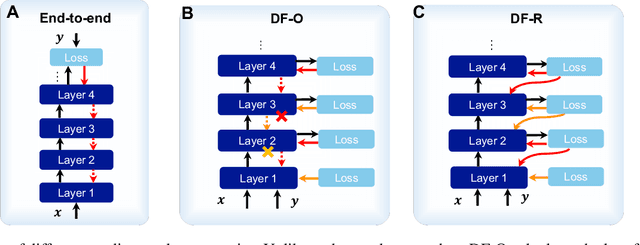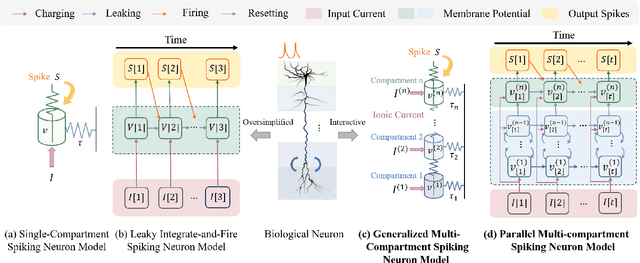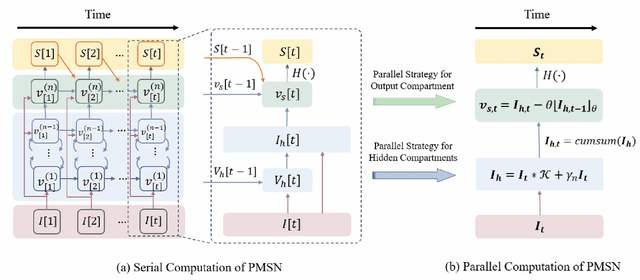Jibin Wu
Spiking Neural Networks for Temporal Processing: Status Quo and Future Prospects
Feb 13, 2025Abstract:Temporal processing is fundamental for both biological and artificial intelligence systems, as it enables the comprehension of dynamic environments and facilitates timely responses. Spiking Neural Networks (SNNs) excel in handling such data with high efficiency, owing to their rich neuronal dynamics and sparse activity patterns. Given the recent surge in the development of SNNs, there is an urgent need for a comprehensive evaluation of their temporal processing capabilities. In this paper, we first conduct an in-depth assessment of commonly used neuromorphic benchmarks, revealing critical limitations in their ability to evaluate the temporal processing capabilities of SNNs. To bridge this gap, we further introduce a benchmark suite consisting of three temporal processing tasks characterized by rich temporal dynamics across multiple timescales. Utilizing this benchmark suite, we perform a thorough evaluation of recently introduced SNN approaches to elucidate the current status of SNNs in temporal processing. Our findings indicate significant advancements in recently developed spiking neuron models and neural architectures regarding their temporal processing capabilities, while also highlighting a performance gap in handling long-range dependencies when compared to state-of-the-art non-spiking models. Finally, we discuss the key challenges and outline potential avenues for future research.
MetaLA: Unified Optimal Linear Approximation to Softmax Attention Map
Nov 16, 2024



Abstract:Various linear complexity models, such as Linear Transformer (LinFormer), State Space Model (SSM), and Linear RNN (LinRNN), have been proposed to replace the conventional softmax attention in Transformer structures. However, the optimal design of these linear models is still an open question. In this work, we attempt to answer this question by finding the best linear approximation to softmax attention from a theoretical perspective. We start by unifying existing linear complexity models as the linear attention form and then identify three conditions for the optimal linear attention design: 1) Dynamic memory ability; 2) Static approximation ability; 3) Least parameter approximation. We find that none of the current linear models meet all three conditions, resulting in suboptimal performance. Instead, we propose Meta Linear Attention (MetaLA) as a solution that satisfies these conditions. Our experiments on Multi-Query Associative Recall (MQAR) task, language modeling, image classification, and Long-Range Arena (LRA) benchmark demonstrate that MetaLA is more effective than the existing linear models.
Towards Ultra-Low-Power Neuromorphic Speech Enhancement with Spiking-FullSubNet
Oct 07, 2024



Abstract:Speech enhancement is critical for improving speech intelligibility and quality in various audio devices. In recent years, deep learning-based methods have significantly improved speech enhancement performance, but they often come with a high computational cost, which is prohibitive for a large number of edge devices, such as headsets and hearing aids. This work proposes an ultra-low-power speech enhancement system based on the brain-inspired spiking neural network (SNN) called Spiking-FullSubNet. Spiking-FullSubNet follows a full-band and sub-band fusioned approach to effectively capture both global and local spectral information. To enhance the efficiency of computationally expensive sub-band modeling, we introduce a frequency partitioning method inspired by the sensitivity profile of the human peripheral auditory system. Furthermore, we introduce a novel spiking neuron model that can dynamically control the input information integration and forgetting, enhancing the multi-scale temporal processing capability of SNN, which is critical for speech denoising. Experiments conducted on the recent Intel Neuromorphic Deep Noise Suppression (N-DNS) Challenge dataset show that the Spiking-FullSubNet surpasses state-of-the-art methods by large margins in terms of both speech quality and energy efficiency metrics. Notably, our system won the championship of the Intel N-DNS Challenge (Algorithmic Track), opening up a myriad of opportunities for ultra-low-power speech enhancement at the edge. Our source code and model checkpoints are publicly available at https://github.com/haoxiangsnr/spiking-fullsubnet.
HM3: Hierarchical Multi-Objective Model Merging for Pretrained Models
Sep 27, 2024



Abstract:Model merging is a technique that combines multiple large pretrained models into a single model with enhanced performance and broader task adaptability. It has gained popularity in large pretrained model development due to its ability to bypass the need for original training data and further training processes. However, most existing model merging approaches focus solely on exploring the parameter space, merging models with identical architectures. Merging within the architecture space, despite its potential, remains in its early stages due to the vast search space and the challenges of layer compatibility. This paper marks a significant advance toward more flexible and comprehensive model merging techniques by modeling the architecture-space merging process as a reinforcement learning task. We train policy and value networks using offline sampling of weight vectors, which are then employed for the online optimization of merging strategies. Moreover, a multi-objective optimization paradigm is introduced to accommodate users' diverse task preferences, learning the Pareto front of optimal models to offer customized merging suggestions. Experimental results across multiple tasks, including text translation, mathematical reasoning, and code generation, validate the effectiveness and superiority of the proposed framework in model merging. The code will be made publicly available after the review process.
Advancing Automated Knowledge Transfer in Evolutionary Multitasking via Large Language Models
Sep 06, 2024



Abstract:Evolutionary Multi-task Optimization (EMTO) is a paradigm that leverages knowledge transfer across simultaneously optimized tasks for enhanced search performance. To facilitate EMTO's performance, various knowledge transfer models have been developed for specific optimization tasks. However, designing these models often requires substantial expert knowledge. Recently, large language models (LLMs) have achieved remarkable success in autonomous programming, aiming to produce effective solvers for specific problems. In this work, a LLM-based optimization paradigm is introduced to establish an autonomous model factory for generating knowledge transfer models, ensuring effective and efficient knowledge transfer across various optimization tasks. To evaluate the performance of the proposed method, we conducted comprehensive empirical studies comparing the knowledge transfer model generated by the LLM with existing state-of-the-art knowledge transfer methods. The results demonstrate that the generated model is able to achieve superior or competitive performance against hand-crafted knowledge transfer models in terms of both efficiency and effectiveness.
Distance-Forward Learning: Enhancing the Forward-Forward Algorithm Towards High-Performance On-Chip Learning
Aug 27, 2024



Abstract:The Forward-Forward (FF) algorithm was recently proposed as a local learning method to address the limitations of backpropagation (BP), offering biological plausibility along with memory-efficient and highly parallelized computational benefits. However, it suffers from suboptimal performance and poor generalization, largely due to inadequate theoretical support and a lack of effective learning strategies. In this work, we reformulate FF using distance metric learning and propose a distance-forward algorithm (DF) to improve FF performance in supervised vision tasks while preserving its local computational properties, making it competitive for efficient on-chip learning. To achieve this, we reinterpret FF through the lens of centroid-based metric learning and develop a goodness-based N-pair margin loss to facilitate the learning of discriminative features. Furthermore, we integrate layer-collaboration local update strategies to reduce information loss caused by greedy local parameter updates. Our method surpasses existing FF models and other advanced local learning approaches, with accuracies of 99.7\% on MNIST, 88.2\% on CIFAR-10, 59\% on CIFAR-100, 95.9\% on SVHN, and 82.5\% on ImageNette, respectively. Moreover, it achieves comparable performance with less than 40\% memory cost compared to BP training, while exhibiting stronger robustness to multiple types of hardware-related noise, demonstrating its potential for online learning and energy-efficient computation on neuromorphic chips.
PMSN: A Parallel Multi-compartment Spiking Neuron for Multi-scale Temporal Processing
Aug 27, 2024



Abstract:Spiking Neural Networks (SNNs) hold great potential to realize brain-inspired, energy-efficient computational systems. However, current SNNs still fall short in terms of multi-scale temporal processing compared to their biological counterparts. This limitation has resulted in poor performance in many pattern recognition tasks with information that varies across different timescales. To address this issue, we put forward a novel spiking neuron model called Parallel Multi-compartment Spiking Neuron (PMSN). The PMSN emulates biological neurons by incorporating multiple interacting substructures and allows for flexible adjustment of the substructure counts to effectively represent temporal information across diverse timescales. Additionally, to address the computational burden associated with the increased complexity of the proposed model, we introduce two parallelization techniques that decouple the temporal dependencies of neuronal updates, enabling parallelized training across different time steps. Our experimental results on a wide range of pattern recognition tasks demonstrate the superiority of PMSN. It outperforms other state-of-the-art spiking neuron models in terms of its temporal processing capacity, training speed, and computation cost. Specifically, compared with the commonly used Leaky Integrate-and-Fire neuron, PMSN offers a simulation acceleration of over 10 $\times$ and a 30 % improvement in accuracy on Sequential CIFAR10 dataset, while maintaining comparable computational cost.
Global-Local Convolution with Spiking Neural Networks for Energy-efficient Keyword Spotting
Jun 19, 2024



Abstract:Thanks to Deep Neural Networks (DNNs), the accuracy of Keyword Spotting (KWS) has made substantial progress. However, as KWS systems are usually implemented on edge devices, energy efficiency becomes a critical requirement besides performance. Here, we take advantage of spiking neural networks' energy efficiency and propose an end-to-end lightweight KWS model. The model consists of two innovative modules: 1) Global-Local Spiking Convolution (GLSC) module and 2) Bottleneck-PLIF module. Compared to the hand-crafted feature extraction methods, the GLSC module achieves speech feature extraction that is sparser, more energy-efficient, and yields better performance. The Bottleneck-PLIF module further processes the signals from GLSC with the aim to achieve higher accuracy with fewer parameters. Extensive experiments are conducted on the Google Speech Commands Dataset (V1 and V2). The results show our method achieves competitive performance among SNN-based KWS models with fewer parameters.
Towards Next Era of Multi-objective Optimization: Large Language Models as Architects of Evolutionary Operators
Jun 13, 2024



Abstract:Multi-objective optimization problems (MOPs) are prevalent in various real-world applications, necessitating sophisticated solutions that balance conflicting objectives. Traditional evolutionary algorithms (EAs), while effective, often rely on domain-specific expert knowledge and iterative tuning, which can impede innovation when encountering novel MOPs. Very recently, the emergence of Large Language Models (LLMs) has revolutionized software engineering by enabling the autonomous development and refinement of programs. Capitalizing on this advancement, we propose a new LLM-based framework for evolving EA operators, designed to address a wide array of MOPs. This framework facilitates the production of EA operators without the extensive demands for expert intervention, thereby streamlining the design process. To validate the efficacy of our approach, we have conducted extensive empirical studies across various categories of MOPs. The results demonstrate the robustness and superior performance of our LLM-evolved operators.
Unlock the Power of Algorithm Features: A Generalization Analysis for Algorithm Selection
May 18, 2024



Abstract:In the field of algorithm selection research, the discussion surrounding algorithm features has been significantly overshadowed by the emphasis on problem features. Although a few empirical studies have yielded evidence regarding the effectiveness of algorithm features, the potential benefits of incorporating algorithm features into algorithm selection models and their suitability for different scenarios remain unclear. It is evident that relying solely on empirical research cannot adequately elucidate the mechanisms underlying performance variations. In this paper, we address this gap by proposing the first provable guarantee for algorithm selection based on algorithm features, taking a generalization perspective. We analyze the benefits and costs associated with algorithm features and investigate how the generalization error is affected by several factors. Specifically, we examine adaptive and predefined algorithm features under transductive and inductive learning paradigms, respectively, and derive upper bounds for the generalization error based on their model's Rademacher complexity. Our theoretical findings not only provide tight upper bounds, but also offer analytical insights into the impact of various factors, including model complexity, the number of problem instances and candidate algorithms, model parameters and feature values, and distributional differences between the training and test sets. Notably, we demonstrate that algorithm feature-based models outperform traditional models relying solely on problem features in complex multi-algorithm scenarios in terms of generalization, and are particularly well-suited for deployment in scenarios under distribution shifts, where the generalization error exhibits a positive correlation with the chi-square distance between training and test sets.
 Add to Chrome
Add to Chrome Add to Firefox
Add to Firefox Add to Edge
Add to Edge